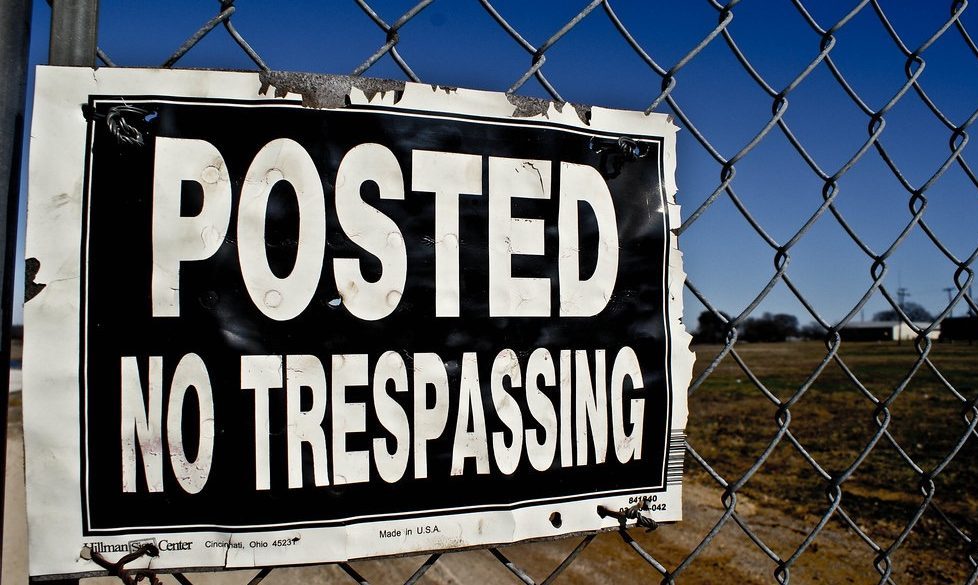Post Your Curtilage Boundaries! In addition to “No Trespassing” signs.

In recent years American courts have not bolstered private property rights. It has been well-publicized how the courts have deferred to local governments and even to private land developers, in allowing Eminent Domain declarations to deprive even multi-generational land owners of their property, for “public use”. This has gone far beyond just widening highways. Some of these “takings” have been for boondoggles like building privately-owned sports stadiums and shopping malls. But much less well known are court cases at the state and Federal levels that have upheld the assumed right of law enforcement officers to enter and surveil private lands with impunity, under the Open Fields Doctrine.
The Open Fields Doctrine is a modern derivation of the English Common Law, dating back to the era of Divine Right Kings. As early as 1217, the British monarchy established the offices of “The Keepers of The King’s Deer” — also known as Rangers or Game Wardens. As officers of the crown, game wardens were given carte blanche to trespass on private lands at any hour of the day, to spy on suspected poachers, to seize evidence, extract confessions, and to make arrests. The notorious Sheriff of Nottingham was one such Game Warden. In medieval times, wardens were little more than armed and armored thugs whose job was to punish any “knave” caught poaching the king’s deer. Some of them even assumed the power of summary execution. (See: Nathaniel Boothe’s The Rights of His Majesty’s Forest Asserted.)
Some states have rejected Open Fields Doctrine and have greater Fourth Amendment protections for land owners, but most do not. Federal magistrates — including those adjudicating Federal Fish and Game law violations — use the Open Fields standard, even on lands that are posted “No Trespassing.”
In the 20th and 21st Centuries, the courts have enshrined both the Plain View Doctrine and the Open Fields Doctrine, but have absurdly extended them to anywhere outside the immediate surroundings of a house and outbuildings. Legally, this vicinity is known as the curtilage of a house. To this day, in most states, any sworn law enforcement officers can traipse all over your acreage at any time, and even install surveillance cameras without a warrant, only with the exception of your home’s curtilage. And the courts have held that even the curtilage of your home can be briefly entered (but not searched) without a warrant, for purposes of an investigation, a consensual “knock and talk”, or a “welfare check” precipitated by a call. And some courts have ruled that drones can over-fly a property to surveil it, again without a warrant.
Oddly, the courts have never defined any standard dimensions of curtilage. It seems to vary from state to state and even from case to case. Within city limits, properties of up to a couple of acres could safely be assumed to all be within curtilage. But in rural areas, the law gets fuzzy. The amount of timber on your land plays into this, because that affects the line of sight and the extent of “plain view.” Posting a property with “No Trespassing” signs is insufficient, in the eyes of the law. The problem, in essence, is that a property line does not necessarily equal a curtilage boundary.
As a land owner, the onus is on you to post your property in defense against any would-be property rights violators, namely: hunters, fishermen, hikers, and law enforcement officers. I suggest that in addition to “No Trespassing” signs around your land’s full perimeter you now must post Curtilage Boundary signs, to properly assert and exercise your rights, in particular as an overt warning to public officials. In effect, when it comes to curtilage, we must name it and claim It. If you don’t post your intent, then some crook with a badge could claim that the curtilage of your house does not extend much beyond your front porch.
Specifically, I suggest that after you walk your property lines and post “No Trespassing” signs, you also do a second personal survey, to determine where you might place Curtilage Boundary signs, presumably at 100-foot intervals. (Consult your state laws, for details.) If your house and outbuildings are in direct line of sight from any portion of your property lines, then you can safely assume that that portion of your property line is also your curtilage boundary, and that it can and should be posted as such. For any part of your property that is not in direct line of sight of your house and outbuildings, then I suggest you post Curtilage Boundary signs at a 250-foot distance from the farthest structure corners.
You can have Curtilage Boundary signs made locally, by a printing shop. These days, printed Tyvek signs are the most economical choice. These have surprising longevity. Even longer-lasting custom aluminum signs are affordable. Here is the sign wording that I suggest:
Notice to Public OfficialsThe area within these signs constitutes the non-public access private curtilage of this property, per three relevant Supreme Court cases:
No entry, search, or electronic/photographic/video/audio surveillance whatsoever is authorized by the landowner within this curtilage. Violators will lose qualified immunity and be prosecuted for trespassing and/or sued personally under 42 U.S. Code § 1983 for deprivation of rights. |
Keep in mind the following provisos:
Once again, I encourage my readers to post their property lines and also establish and post their Curtilage Boundaries. – JWR
